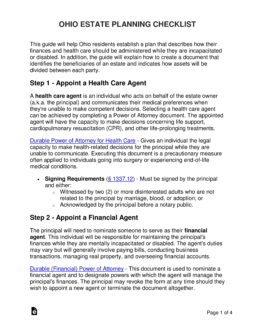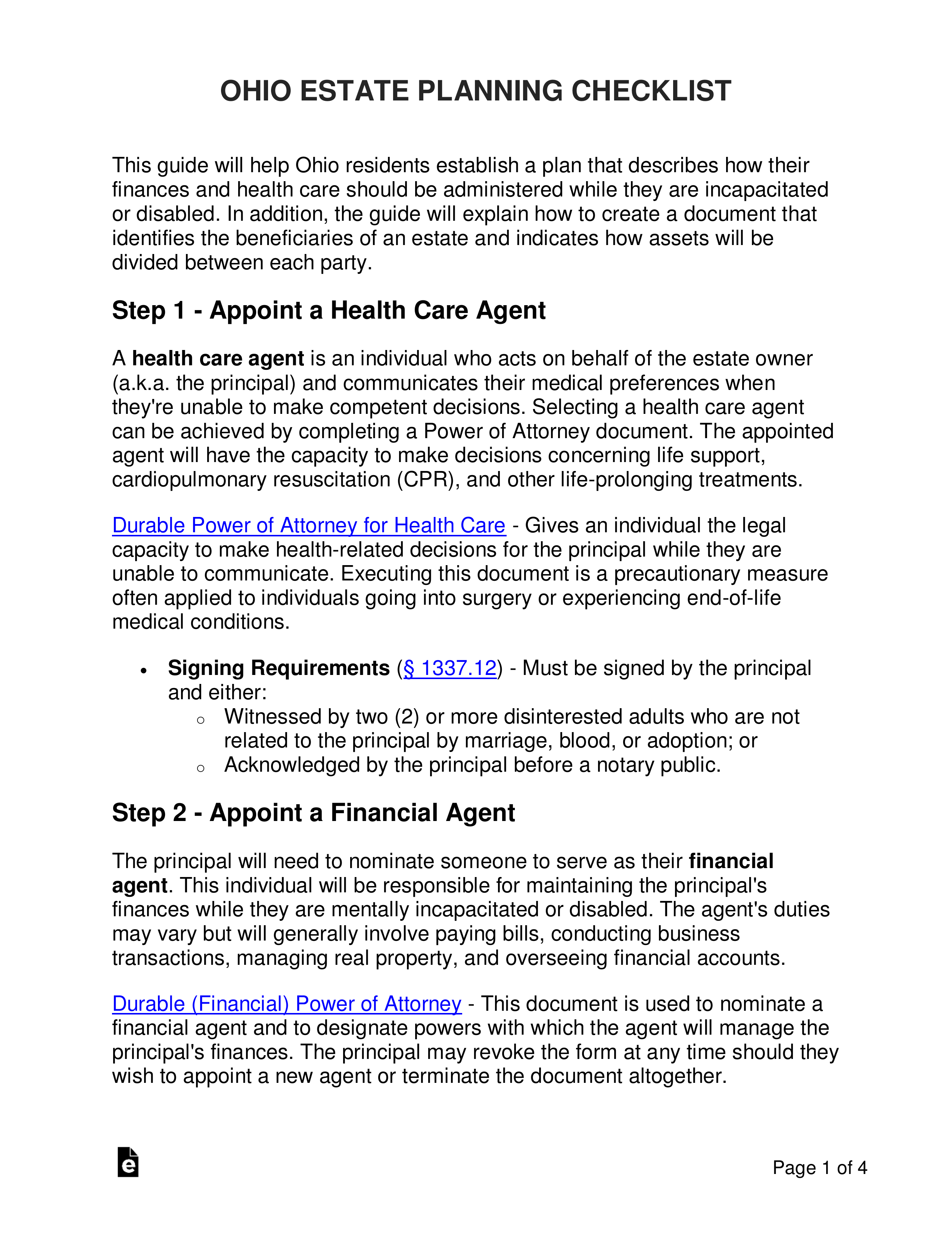Updated March 05, 2024
An Ohio estate planning checklist is a guide that can help individuals as they prepare their estate for death, unforeseen medical conditions, and extended absences. The instructions begin by explaining the use of the Durable Power of Attorney for Health Care and Durable (Financial) Power of Attorney forms. Both documents designate agents to act on behalf of another party when they’re incapable of making decisions on their own. The checklist also covers how to make an estate distribution document (Last Will and Testament or Living Trust).
How to Create an Estate Plan in Ohio (6 steps)
- Appoint a Health Care Agent
- Appoint a Financial Agent
- Create a List of Current Assets
- Decide Who the Beneficiaries Are
- Make an Estate Distribution Form
- Find a Secure Location to Store the Estate Documents
This guide will help Ohio residents establish a plan that describes how their finances and health care should be administered while they are incapacitated or disabled. In addition, the guide will explain how to create a document that identifies the beneficiaries of an estate and indicates how assets will be divided between each party.
1. Appoint a Health Care Agent
A health care agent is an individual who acts on behalf of the estate owner (a.k.a. the principal) and communicates their medical preferences when they’re unable to make competent decisions. Selecting a health care agent can be achieved by completing a Power of Attorney document. The appointed agent will have the capacity to make decisions concerning life support, cardiopulmonary resuscitation (CPR), and other life-prolonging treatments.
Durable Power of Attorney for Health Care – Gives an individual the legal capacity to make health-related decisions for the principal while they are unable to communicate. Executing this document is a precautionary measure often applied to individuals going into surgery or experiencing end-of-life medical conditions.
- Signing Requirements – Must be signed by the principal and either:
- Witnessed by two (2) or more disinterested adults who are not related to the principal by marriage, blood, or adoption; or
- Acknowledged by the principal before a notary public.[1]
2. Appoint a Financial Agent
The principal will need to nominate someone to serve as their financial agent. This individual will be responsible for maintaining the principal’s finances while they are mentally incapacitated or disabled. The agent’s duties may vary but will generally involve paying bills, conducting business transactions, managing real property, and overseeing financial accounts.
Durable (Financial) Power of Attorney – This document is used to nominate a financial agent and to designate powers with which the agent will manage the principal’s finances. The principal may revoke the form at any time should they wish to appoint a new agent or terminate the document altogether.
- Signing Requirements – The principal must sign the document or direct another individual to sign in their presence. The signature is presumed to be authentic if the principal appears before a notary public and acknowledges the signature.[2]
Financial Powers Allowed
- Real Property[3]
- Tangible Personal Property[4]
- Stocks and Bonds[5]
- Commodities and Options[6]
- Banks and Other Financial Institutions[7]
- Operation of Entity or Business[8]
- Insurance and Annuities[9]
- Estates, Trusts, and Other Beneficial Interests[10]
- Claims and Litigation[11]
- Personal and Family Maintenance[12]
- Benefits from Governmental Programs or Civil or Military Service[13]
- Retirement Plans[14]
- Taxes[15]
- Digital Assets[16]
3. Create a List of Current Assets
4. Decide Who the Beneficiaries Are
5. Make an Estate Distribution Form
The next step requires the principal to create a document that states how their assets will be distributed following their death. This document will be used to identify the beneficiaries and provide a description of the assets that each party is entitled to inherit. The following documents are applicable in this circumstance:
Last Will and Testament (‘Will’) – This is a legal document used by the principal to nominate beneficiaries and allocate assets for distribution. Upon the principal’s death, the Last Will and Testament will go through the probate process, meaning that a court will assess the document before allowing the assets to be distributed. The probate process can take several months to complete and may require additional costs paid by the executor of the estate.
- Signing Requirements – Every Will must be signed by the principal and two (2) or more competent individuals who either saw the principal sign the Will or heard the principal acknowledge their signature.[17]
Living Trust (Revocable) – This form creates an entity to which the principal can transfer ownership of their assets. The principal is allowed to manage the trust and benefit from the assets until their death. Like a Last Will and Testament, a Living Trust will specify the beneficiaries and describe the assets that each will inherit. However, a Living Trust will not go through the probate process thus the estate can be distributed to the beneficiaries immediately and without the supervision of the court.
Signing Requirements (No Statutory Signing Requirement) – A Living Trust should be signed by the creator in the presence of two (2) witnesses and acknowledged before a notary public.
Note: Both the Last Will and Testament and Living Trust may be used together.
6. Find a Secure Location to Store the Estate Documents
Ohio Estate Planning Laws
- Durable Power of Attorney for Health Care – § 1337.12
- Durable (Financial) Power of Attorney – § 1337.60
- Last Will and Testament – Chapter 2107
- Revocable Living Trust – Chapter 5804


